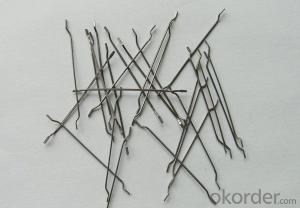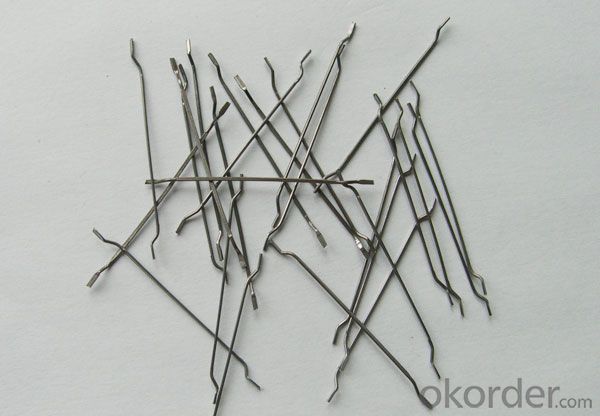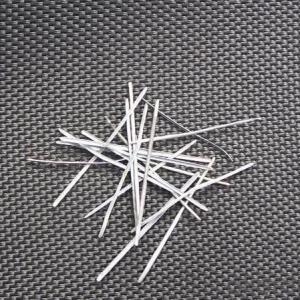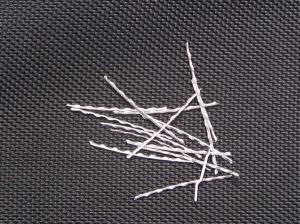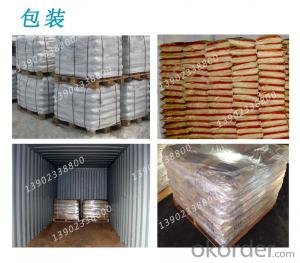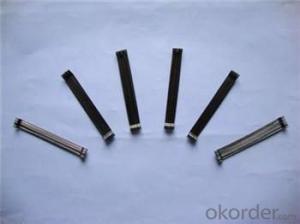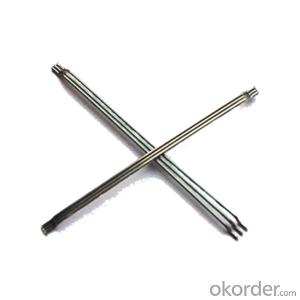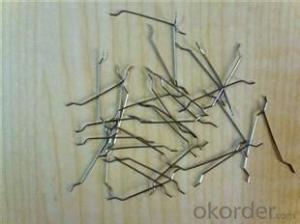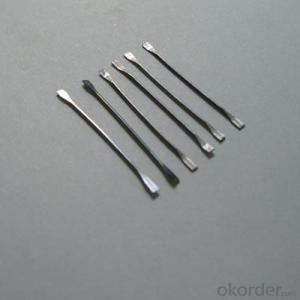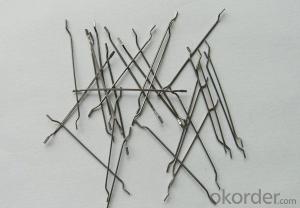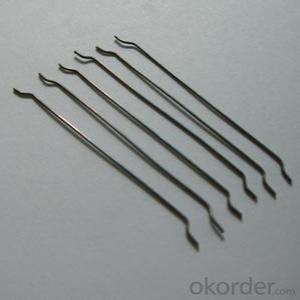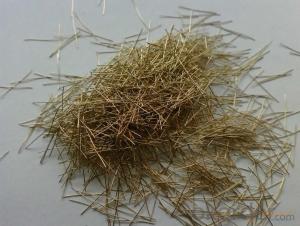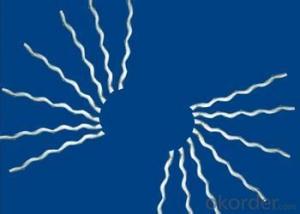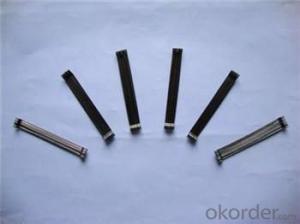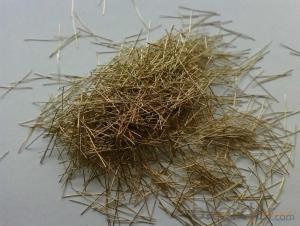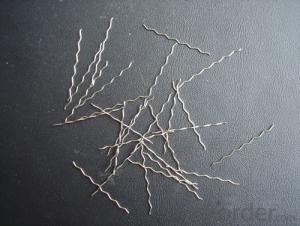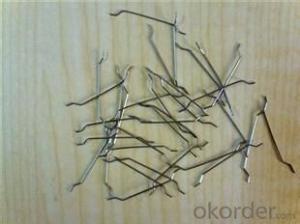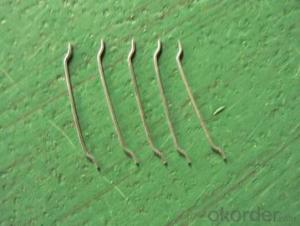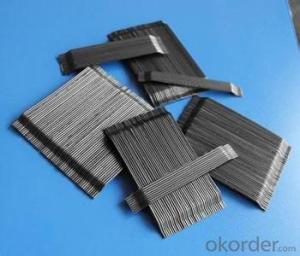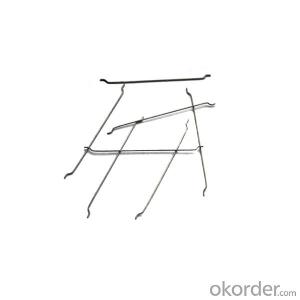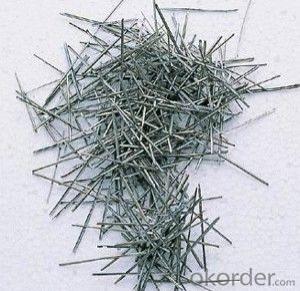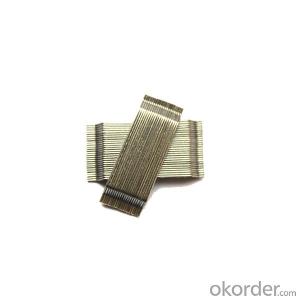Melt Extract Stainless Steel Fiber with Copper Coated Hooked Ends Steel Fiber from China
- Loading Port:
- Tianjin
- Payment Terms:
- TT OR LC
- Min Order Qty:
- 1000 kg
- Supply Capability:
- 30000 kg/month
OKorder Service Pledge
OKorder Financial Service
You Might Also Like
Quick Details
Place of Origin: Jiangsu, China (Mainland)
Model Number: HT-ST
Material: Steel
Specifications
(1) greatly improve concrete bonding and tensile strength
(2) improve mechanical performance concrete
(3) prevent the damage to the concrete
(4) decrease the danger from crack of the concrete
(5) provide exceptional load stability and durability
Uses
Steel fiber concrete has already been used for and wide on to many fields,such as road,bridge ,airport runway,tunnel ,culvert,hydro-power project,inner lining of underground construction.Port and pier,ocean project,nuclear test base rocket launch site,anti-earthquake building,ect
Picture
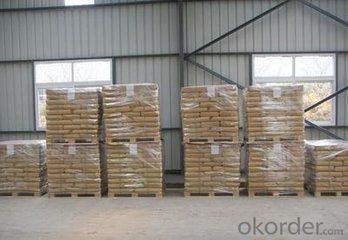
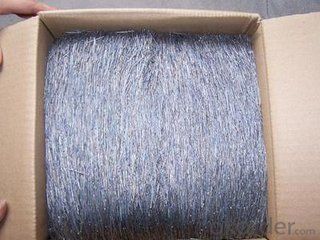

Steel fiber
FAQ
1. Directadding steel fibers to the belt,the rows of steel fiber as a whole,each of the concrete uniformly dispersed Corner
2. A water-soluble glue starts to dissolve,in a row of steel fibers in a dispersion premise,dispersed again in every corner of the monofilament fiber,showing a perspective view in the concrete of the fiber web, which play the role of an overall reinforcement.
3. Compare to the monofilament fiber,the glued steel fiber wouldn't be tied up,to ensure that the fibers in the concrete mixing does not agglomerate,distributed evenly.
- Q: What is the effect of melt extract stainless steel fiber on the dimensional stability of concrete?
- The use of melt extract stainless steel fiber in concrete has a significant effect on the dimensional stability of the material. These fibers are added to the concrete mixture during the mixing process, where they are evenly dispersed throughout the mixture. One of the main benefits of melt extract stainless steel fiber is its ability to enhance the overall strength and durability of concrete. The fibers act as reinforcement, providing additional tensile strength to the material. This reinforcement helps to prevent cracking and shrinkage, which are common issues in concrete structures. By reducing cracking and shrinkage, melt extract stainless steel fiber improves the dimensional stability of concrete. This means that the concrete maintains its original shape and size over time, even under varying environmental conditions such as temperature changes or moisture exposure. The addition of these fibers also improves the overall performance of the concrete in terms of resistance to impact, abrasion, and fatigue. This makes it particularly useful in applications where the concrete will be subjected to heavy loads or frequent wear and tear. Furthermore, melt extract stainless steel fiber can also enhance the fire resistance of concrete. The fibers have a high melting point, which helps to slow down the spread of fire and prevent structural collapse. This is especially important in buildings and structures where fire safety is a concern. Overall, the use of melt extract stainless steel fiber in concrete greatly improves its dimensional stability, strength, and durability. This leads to longer-lasting, more reliable concrete structures that are better able to withstand various environmental and mechanical forces.
- Q: What is the recommended dosage of melt extract stainless steel fiber in concrete mixtures?
- The dosage of melt extract stainless steel fiber in concrete mixtures can vary depending on the specific application and desired outcome. Typically, the dosage ranges from 20 to 40 kilograms per cubic meter (kg/m³) of concrete. However, it is essential to seek advice from the manufacturer or a structural engineer to determine the optimal dosage for a particular project. Several factors can influence the dosage, including the intended use of the concrete (such as industrial flooring, precast elements, or shotcrete), the required level of reinforcement, and the desired properties of the stainless steel fiber, such as enhanced crack resistance, impact resistance, or durability. Furthermore, it is important to note that the length and diameter of the stainless steel fibers can impact the dosage. Longer and thicker fibers generally require a lower dosage to achieve the desired reinforcement effect. Ultimately, consulting with professionals and considering the specific requirements and objectives of the project is crucial in determining the most suitable dosage of melt extract stainless steel fiber in concrete mixtures.
- Q: How does melt extract stainless steel fiber improve the resistance of concrete to impact loads?
- Melt extract stainless steel fiber improves the resistance of concrete to impact loads in several ways. Firstly, the addition of stainless steel fibers to concrete significantly enhances its tensile strength and ductility. These fibers act as a reinforcement, distributing the applied load more evenly throughout the concrete matrix and reducing the concentration of stress points. This helps to prevent the formation and propagation of cracks, increasing the overall resistance of the concrete to impact loads. Moreover, the unique properties of stainless steel, such as high strength, corrosion resistance, and durability, contribute to the improved impact resistance of concrete. Stainless steel fibers are extremely tough and can withstand high impact forces without breaking or deforming. This toughness allows them to effectively absorb and dissipate energy during impact, preventing the occurrence of catastrophic failure. Additionally, the small size and high aspect ratio of melt extract stainless steel fibers promote better bonding between the fibers and the concrete matrix. This strong bond ensures that the fibers remain well-anchored within the concrete, even under high impact loads. This, in turn, increases the overall strength and integrity of the concrete, making it more resistant to impact-induced damage. Furthermore, the addition of stainless steel fibers can also enhance the post-cracking behavior of concrete. When cracks do occur due to impact loads, the fibers help to hold the cracked sections together, preventing further separation and limiting the extent of damage. This post-cracking behavior contributes to the overall improvement in the resistance of concrete to impact loads. In summary, melt extract stainless steel fiber improves the resistance of concrete to impact loads by enhancing its tensile strength, ductility, and toughness. The fibers contribute to a more even distribution of applied loads and prevent the formation and propagation of cracks. Their strong bond with the concrete matrix and ability to absorb and dissipate energy during impact further enhance the impact resistance of the concrete.
- Q: Can melt extract stainless steel fiber be used in hydraulic structure construction?
- Yes, melt extract stainless steel fiber can be used in hydraulic structure construction. Stainless steel fiber provides enhanced durability and corrosion resistance, making it suitable for use in hydraulic structures that are exposed to water and other corrosive elements. It can be used in various applications such as slabs, tunnel linings, and foundations to improve the structural strength and crack resistance. Additionally, stainless steel fiber can also enhance the ductility and toughness of the concrete, resulting in improved resistance to impact and seismic forces. Therefore, melt extract stainless steel fiber is a viable option for reinforcing hydraulic structures and ensuring their long-term stability and performance.
- Q: What is the recommended mix design for concrete containing melt extract stainless steel fiber?
- The recommended mix design for concrete containing melt extract stainless steel fiber typically includes a higher dosage of fiber to enhance the mechanical properties of the concrete. It is generally recommended to use a fiber dosage of around 40-60 kg/m3 to achieve optimal results. Additionally, the mix design should consider the desired strength, workability, and durability requirements of the concrete. It is advisable to consult with a structural engineer or a concrete specialist to determine the specific mix design for a project involving melt extract stainless steel fiber.
- Q: Can melt extract stainless steel fiber be used in the construction of parking structures?
- Indeed, the utilization of melt extract stainless steel fiber is feasible for the construction of parking structures. It is a prevalent practice to employ stainless steel fibers as reinforcement in concrete to augment its robustness and endurance. This type of fiber possesses the ability to enhance the resistance of concrete against cracks and impacts, rendering it more suitable for areas with high vehicular movement, like parking structures. Furthermore, the outstanding resistance to corrosion exhibited by stainless steel fibers enables them to withstand adverse environmental conditions, thus guaranteeing the durability of the parking structure. In summary, incorporating melt extract stainless steel fiber into the construction of parking structures is a viable alternative that can bolster their structural integrity and prolong their lifespan.
- Q: What is the effect of melt extract stainless steel fiber on the autogenous shrinkage of concrete?
- The melt extract stainless steel fiber has a significant effect on reducing the autogenous shrinkage of concrete. Autogenous shrinkage refers to the inherent self-desiccation and subsequent volume reduction of concrete due to the hydration process. When stainless steel fibers are added to concrete, they create a three-dimensional reinforcement network within the matrix. This network helps to enhance the overall tensile strength and ductility of the concrete. Additionally, the stainless steel fibers act as micro-reinforcements, preventing the formation and propagation of cracks during the early stages of concrete hydration. By reducing the formation of cracks, the stainless steel fibers minimize the potential for moisture loss from the concrete. This, in turn, reduces the autogenous shrinkage. The stainless steel fibers act as a barrier, hindering the evaporation of water from the concrete and maintaining a higher moisture content within the matrix. Moreover, the melt extract stainless steel fibers have a higher aspect ratio and better dispersion compared to other types of fibers, such as polypropylene or carbon fibers. This improved dispersion ensures a more uniform distribution of the fibers throughout the concrete, further enhancing their effectiveness in reducing autogenous shrinkage. Overall, the addition of melt extract stainless steel fibers to concrete significantly reduces the autogenous shrinkage by preventing crack formation and minimizing moisture loss. This results in a more durable and crack-resistant concrete structure.
- Q: Is melt extract stainless steel fiber compatible with different types of curing methods?
- Yes, melt extract stainless steel fiber is compatible with different types of curing methods. Its high temperature resistance and durability make it suitable for both heat curing and chemical curing methods. Additionally, its excellent corrosion resistance ensures compatibility with various curing agents and processes.
- Q: What is the impact of melt extract stainless steel fiber on the shrinkage of concrete?
- The shrinkage of concrete can be significantly affected by the utilization of melt extract stainless steel fiber. To strengthen the concrete and prevent cracking, stainless steel fibers are commonly added to concrete mixes. During the curing process, concrete tends to shrink as water evaporates, leading to cracks and decreased structural durability. However, the inclusion of melt extract stainless steel fibers in the concrete mix effectively controls and minimizes shrinkage. These stainless steel fibers act as reinforcement within the concrete, promoting a more even distribution of stress and strain. This reinforcement restrains concrete shrinkage and provides greater resistance against cracking. The enhanced tensile strength of the concrete also limits overall shrinkage, resulting in a stronger and longer-lasting structure. Furthermore, the melt extract stainless steel fibers possess high corrosion resistance, further enhancing their effectiveness in mitigating shrinkage. This corrosion resistance ensures the fibers maintain their structural integrity over time, even in harsh environmental conditions. Overall, the integration of melt extract stainless steel fibers in concrete significantly reduces shrinkage and improves the material's overall performance. By minimizing cracking and enhancing durability, structures constructed with this type of concrete exhibit a longer lifespan and require less maintenance.
- Q: Can melt extract stainless steel fiber be used in concrete bridge decks?
- Yes, melt extract stainless steel fiber can be used in concrete bridge decks. Stainless steel fibers are commonly used as reinforcement in concrete structures, including bridge decks. These fibers improve the overall strength and durability of the concrete, enhancing its resistance to cracking and increasing its load-bearing capacity. Melt extract stainless steel fibers are known for their high tensile strength and corrosion resistance, making them an excellent choice for bridge decks exposed to harsh environmental conditions. Additionally, these fibers can help control shrinkage and prevent the formation of cracks, enhancing the long-term performance and service life of the bridge decks. Overall, melt extract stainless steel fiber is a suitable and beneficial reinforcement option for concrete bridge decks.
Send your message to us
Melt Extract Stainless Steel Fiber with Copper Coated Hooked Ends Steel Fiber from China
- Loading Port:
- Tianjin
- Payment Terms:
- TT OR LC
- Min Order Qty:
- 1000 kg
- Supply Capability:
- 30000 kg/month
OKorder Service Pledge
OKorder Financial Service
Similar products
Hot products
Hot Searches
Related keywords
